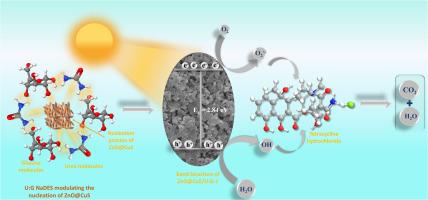Tailored ZnO/CuS nanoarchitectures self-assembled in natural deep eutectic solvents for enhanced photocatalytic degradation of noxious water contaminants
IF 6.3
2区 材料科学
Q2 CHEMISTRY, PHYSICAL
引用次数: 0
Abstract
The photocatalytic properties of catalysts invariably rely on their morphological and electronic attributes. Accordingly, several strategies focused on affecting these two properties have been developed to improve the performance of photocatalytic systems. However, almost every one of those strategies employs cost-intensive chemical modification, which in most cases is environmentally hazardous. In this article, we have demonstrated the effect of natural deep eutectic solvents (NaDESs) in fine tuning the morphological and electronic attributes of a model photocatalyst, ZnO:CuS nanocomposite. Typically, a series of ZnO:CuS catalysts were designed by processing in varied concentrations of urea: fructose and urea: glucose NaDESs. The developed systems were adequately characterized and ZnO:CuS/U:G-1 system displayed best morphological, electronic and surface potential properties. Subsequently, ZnO:CuS/U:G-1 system also showed best photocatalytic performance towards both model water contaminants, tetracycline hydrochloride and malachite green. Importantly, the photocatalytic performance of this ZnO:CuS/U:G-1 system was also compared with ZnO:CuS prepared in conventional solvents like water and ethylene glycol and significant improvement in the morphological, electronic and photocatalytic properties was observed. This presented study shows that how a simple solvent-based strategy can induce changes of significant magnitude, which are otherwise difficult to achieve in a cost-effective and environmentally benign manner.

在天然深共晶溶剂中自组装的ZnO/ cu纳米结构增强了有害水污染物的光催化降解
催化剂的光催化性能总是依赖于它们的形态和电子属性。因此,已经开发了几种专注于影响这两种性质的策略来改善光催化系统的性能。然而,几乎所有这些战略都采用成本高昂的化学改性,在大多数情况下对环境有害。在本文中,我们证明了天然深共晶溶剂(NaDESs)在微调ZnO: cu纳米复合材料模型光催化剂的形态和电子属性方面的作用。通常,通过在不同浓度的尿素:果糖和尿素:葡萄糖NaDESs中处理一系列ZnO: cu催化剂。对制备的体系进行了充分的表征,ZnO: cu /U:G-1体系表现出最佳的形貌、电子和表面电位性能。ZnO: cu /U:G-1体系对模拟水污染物盐酸四环素和孔雀石绿均表现出最佳的光催化性能。重要的是,该ZnO: cu /U:G-1体系的光催化性能也与在水和乙二醇等常规溶剂中制备的ZnO: cu进行了比较,并观察到形貌、电子和光催化性能的显著改善。这项提出的研究表明,一个简单的基于溶剂的策略如何能引起重大的变化,否则难以实现成本效益和环境友好的方式。
本文章由计算机程序翻译,如有差异,请以英文原文为准。
求助全文
约1分钟内获得全文
求助全文
来源期刊

Surfaces and Interfaces
Chemistry-General Chemistry
CiteScore
8.50
自引率
6.50%
发文量
753
审稿时长
35 days
期刊介绍:
The aim of the journal is to provide a respectful outlet for ''sound science'' papers in all research areas on surfaces and interfaces. We define sound science papers as papers that describe new and well-executed research, but that do not necessarily provide brand new insights or are merely a description of research results.
Surfaces and Interfaces publishes research papers in all fields of surface science which may not always find the right home on first submission to our Elsevier sister journals (Applied Surface, Surface and Coatings Technology, Thin Solid Films)
 求助内容:
求助内容: 应助结果提醒方式:
应助结果提醒方式:


